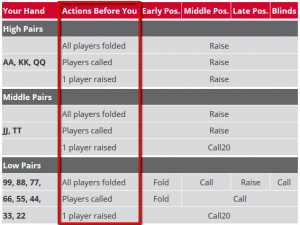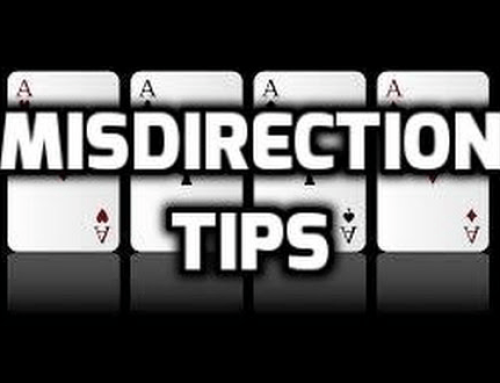A poker hand is typically made up of the best five cards you have at your disposal. For example on the river in a hand of Texas Hold’em you actually have seven cards to choose from, and you are allowed to pick whichever poker combination of the five make up the best hand. This is even true if the two hole cards you have been dealt are the worst, you can instead to ‘play the board’ meaning your best hand is made up of the five shared cards.
What follows is poker rankings from the strongest to the weakest. In the event of a tie, the highest poker cards win.
The poker hands in order
Royal Flush
The strongest poker hand is the royal flush. It consists of Ten, Jack, Queen, King, and Ace, all of the same suit, e.g. spades.

Straight Flush
The second strongest hand in poker is the straight flush. It is composed of five consecutive cards of the same suit. If two players have a straight flush, the one with the highest cards wins.

Four-of-a-kind
A four-of-a-kind is four cards of the same rank, e.g. four Kings. If two players have four-of-a-kind, then the one with the highest four-of-a-kind wins. If they have the same (if four-of-a-kind is on the board), then the player with the highest fifth card wins, since a poker hand is always composed of five cards.

Full House
A full house is a poker combination of a three-of-a-kind and a pair. If two players have a full house, then the one with the highest three-of-a-kind wins. If they have the same one, then the pair counts. A full house is still one of the best poker hands.

Flush
Five cards of the same suit make a flush. If two players have a flush, then the one with the highest cards wins.

Straight
Five consecutive cards are called a straight. If two players have a straight, the one with the highest cards wins.

Three-of-a-kind
A three-of-a-kind is a poker combination of three cards of the same rank. If two players have the same three-of-a-kind, then the other cards, or both cards, determine the winner, since a poker hand is a always composed of five cards.

Two-pair
Two-pair hands are, of course, composed of two pairs. If two players have two-pair, the rank of the higher pair determines the winner. If they have the same higher pair, then the lower one counts. If that is also the same, then the fifth card counts.

Pair
A pair is composed of two cards of the same rank. Since winning poker hands are always composed of five cards, the other three cards are so-called “kickers”. In case two players have the same pair, then the one with the highest kicker wins.

High card
If you don’t even have a pair, then you look at the strength of your poker cards. If there are two players at showdown who don’t have a pair or better, then the one with the highest cards wins.

Understanding poker card strength
One of the core skills in poker is being able to determine whether your hand is strong or not, because many factors contribute to how strong or weak a certain poker card combination actually is.
The number of players helps determine poker hand strength. If lots of players have chosen to play the hand voluntarily, you have to assume they are doing so because they hold strong hands.
However if only two players are involved in a hand, it is less likely. A pair of Aces, for example, is quite a strong poker combination against one player, but against four players it decreases significantly in value.
Your opponents playing style is also a big factor. If they are ‘tight’ meaning they play few hands, then you can expect them to show up with a strong hand when they do. If they are ‘loose’ meaning they play a lot of hands, then the relative strength of their hand usually goes down.
The composition of the community poker cards will determine how many strong potential hands are in play. If you hold three of a kind, but there are four cards to a flush and four cards to a straight, your poker combination strength goes down. This is called a ‘wet’ board. Likewise if the board is made up of out of sequence cards with no flushes possible, your hand strength goes up.
The amount of chips in play also plays a part. In a tournament when chip stacks are shallow, it is not unusual for players to commit their money with weaker holdings to avoid ‘blinding away’. However in cash games, where the stacks are deep, you are less likely to see such risks being taken.
Understanding these complex decisions takes a lot of experience. Until then, you can greatly improve your poker hand strength skills by only choosing the best poker starting hands.
Starting Hands Cart: Which Hands Should You Play?
The Starting Poker Hands Chart
The PokerStrategy.com Starting Hands Chart shows you which hands you should play and how you should play them to get started. Simply print it out and you will always know what to do throughout the entire game.
Because each game type varies significantly we have starting hands charts and strategies for each gametype. Below you will find an example of our starting poker hand charts for No Limit Texas Hold’em.
The No Limit Texas Hold'em Starting Hands Chart
The chart contains four categories of information:
- Your starting hand
- The actions of your opponents before you
- Your position
- How you should play your starting hand considering your current position and the actions of your opponents before you.
| Your Hand | Actions Before You | Early Pos. | Middle Pos. | Late Pos. | Blinds |
| High Pairs | |||||
| All players folded | Raise | ||||
| AA, KK, QQ | Players called | Raise | |||
| 1 player raised | Raise | ||||
| Middle Pairs | |||||
| All players folded | Raise | ||||
| JJ, TT | Players called | Raise | |||
| 1 player raised | Call20 | ||||
| Low Pairs | |||||
| 99, 88, 77, | All players folded | Fold | Call | Raise | Call |
| 66, 55, 44, | Players called | Fold | Call | ||
| 33, 22 | 1 player raised | Call20 | |||
| Your Hand | Actions Before You | Early Pos. | Middle Pos. | Late Pos. | Blinds |
| High Aces (s stands for suited, o stands for offsuit) | |||||
| All players folded | Raise | ||||
| AKo, AKs | Players called | Raise | |||
| 1 player raised | Raise | ||||
| Middle Aces (s stands for suited, o stands for offsuit) | |||||
| AQo, AQs | All players folded | Fold | Raise | ||
| AJs, AJo | Players called | Fold | Raise | Call | |
| ATs, ATo | 1 player raised | Fold | |||
| Low Suited Aces (s stands for suited) | |||||
| A9s, A8s, A7s, | All players folded | Fold | Raise | ||
| A6s, A5s, A4s, | Players called | Fold | Call | ||
| A3s, A2s | 1 player raised | Fold | |||
| Your Hand | Actions Before You | Early Pos. | Middle Pos. | Late Pos. | Blinds |
| Suited Face Cards (s stands for suited) | |||||
| KQs, KJs, KTs, | All players folded | Fold | Raise | ||
| QJs, QTs, | Players called | Fold | Call | ||
| JTs | 1 player raised | Fold | |||
| Offsuit Face Cards (o stands for offsuit) | |||||
| KQo, KJo, KTo, | All players folded | Fold | Raise | ||
| QJo, QTo, | Players called | Fold | Call | ||
| JTo | 1 player raised | Fold | |||
| Suited Connectors | |||||
| T9s, 98s, | All players folded | Fold | Raise | Fold | |
| 87s, 76s, | Players called | Fold | Call | ||
| 65s, 54s | 1 player raised | Fold | |||
| Your Hand | Actions Before You | Early Pos. | Middle Pos. | Late Pos. | Blinds |
| All other hands not considered above | |||||
| All players folded | Fold | ||||
| The rest | Players called | Fold | |||
| 1 player raised | Fold | ||||
The first column: Your hand

In the left column you see the possible starting hands. Each starting hand is abbreviated. AA, for example, stands for two aces, 99 for two nines. If your hand is not included in the chart, you should fold.

Suited cards s: An s behind the hand, as in A9s, stands for suited and means that both of the poker cards you are holding are of the same suit (hearts, diamonds, spades or clubs). Which suit it is doesn’t play any role in Texas hold’em.
- A9s stands for ace nine of the same suit
- A4s stands for ace four of the same suit
- QJs stands for queen jack of the same suit
- QTs stands for queen ten of the same suit
Offsuit cards o: An o behind the hand, as in KQo, stands for offsuit and means that the two poker cards are of two different suits, for example if you are holding a club and a heart.
- KQo stands for king queen of different suits
- QTo stands for queen ten of different suits
- JTo stands for jack ten of different suits
The second column: What action took place before you?

The second column shows you the possible answers to this question. You obviously play differently when someone raised before you, since this is a sign that your opponent has a strong hand.
Columns 3-6: What to do depending on your position?

Your position tells you in what column to look next. If you are in early position, look at the third column, if you are in the Small Blind or Big Blind, look at the last column.
What to do next?
The most important thing to understand is that you should take these poker hand orders only as a starter guide to poker hand strength. Every hand can be a winner or loser, depending on the circumstances. Rather than rely upon these guides as the being definitive, it is important to progress to some of our more advanced strategy sections once you feel you have a good understanding of the poker hand rankings.
src: pokerstrategy.com






